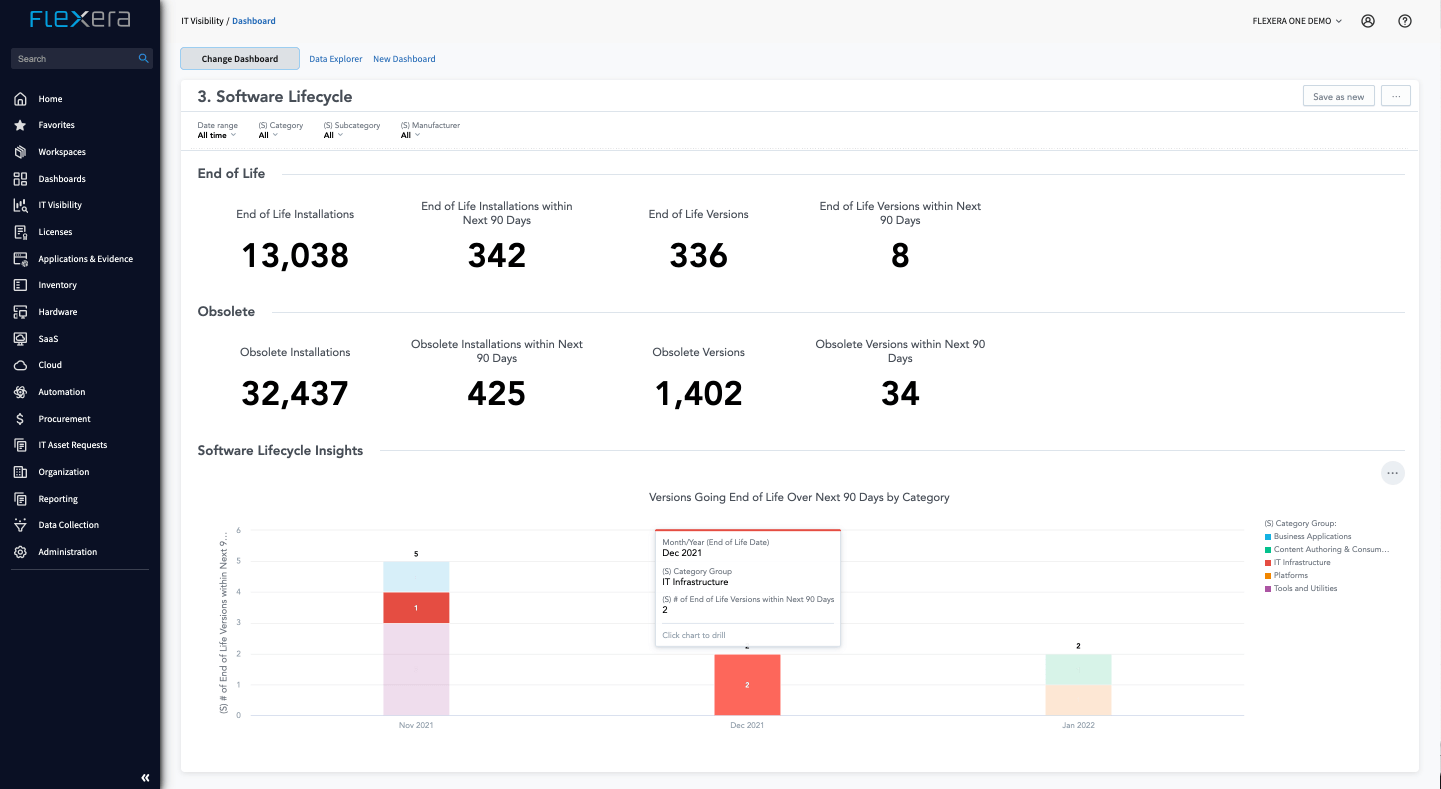End of life (EOL) and end of support (EOS)
What is end of life (EOL) and end of support (EOS)?
End of life and end of support are pivotal milestones in the lifecycle of your IT products. EOL and EOS signify specific phases in a product's life where it either stops receiving comprehensive support (end of life) or any official support at all (end of support). Recognizing these milestones is imperative for your enterprise in terms of security, compliance and operational efficiency, especially when aiming for clear IT visibility.
End of life vs. end of support
While both terms indicate phases where support diminishes for a product, they have distinct meanings:
- End of life (EOL): This is the date after which a product will no longer be sold or renewed. However, it might still receive some form of support, such as security patches
- End of support (EOS): This date marks the complete cessation of all support services for the product. After this date, no new patches, updates or fixes will be released, even for critical vulnerabilities
Why are EOL and EOS critical for organizations?
- Security implications: Products past EOL/EOS are no longer updated, making them susceptible to potential threats, cyberattacks and vulnerabilities
- Operational challenges: Relying on outdated products can lead to inefficiencies, compatibility issues and augmented operational costs
- Regulatory compliance: Many industry standards and regulations mandate the use of supported and updated software, emphasizing the importance of tracking EOL and EOS dates
End of life (EOL) best practices
- Stay informed: Regularly check vendor announcements and updates regarding product lifecycles
- Plan ahead: Begin planning for replacements or upgrades well before the EOL date
- Test new solutions: Before fully transitioning, test new solutions in a controlled environment to ensure compatibility and functionality
End of support (EOS) best practices
- Prioritize critical assets: Identify and prioritize assets that are mission critical to your operations
- Seek extended support: Some vendors offer extended support at an additional cost, which can be a temporary solution while transitioning
- Consider alternatives: If upgrading isn't feasible immediately, consider alternative solutions or workarounds to mitigate risks
Windows 10 EOS
The EOS for a widely used operating system such as Windows 10 can have significant implications for your enterprise. For users, it means no more security updates, which can expose them to vulnerabilities. To address this:
- Upgrade to a supported version: Microsoft regularly releases new versions of its OS. Upgrading ensures continued support and access to the latest features
- Consider alternative operating systems: If upgrading isn't an option, consider transitioning to an alternative OS that meets your needs
- Implement security measures: Enhance security protocols, use robust antivirus solutions and educate users about potential threats
How do EOL and EOS impact IT Visibility?
Clear IT visibility is about having an accurate, up-to-date view of all IT assets. EOL and EOS have a direct impact on this by:
- Influencing IT strategy: Knowing when products are nearing EOL/EOS can shape your IT strategy, guiding decisions about upgrades, replacements or transitions
- Budgeting implications: Predicting costs associated with upgrades, replacements or transitions becomes crucial
- Vendor relationships: EOL/EOS can influence decisions about continuing with a particular vendor or exploring new partnerships
Tackling the challenge of obsolescence
One of the significant challenges that arise from EOL/EOS is the issue of obsolescence. As technology evolves rapidly, products can quickly become obsolete, leading to a myriad of challenges:

- Operational inefficiencies: Outdated technology can hinder performance, leading to operational inefficiencies
- Security vulnerabilities: Obsolete products often lack the latest security patches, making them prime targets for cyber threats
- Increased costs: Maintaining and supporting obsolete products can lead to increased operational costs
Steps to navigate EOL/EOS challenges
Being proactive is the key. To navigate the challenges that may arise with EOL/EOS software, your organization should:
- Maintain an updated IT asset inventory: Regularly update and review your IT asset inventory to track products nearing EOL/EOS
- Plan for upgrades: Allocate budget and resources for timely upgrades or replacements
- Stay informed: Vendors often provide notifications about upcoming EOL/EOS dates. Staying informed allows for proactive planning
Managing EOL and EOS is essential for your organization to ensure a secure, compliant and efficient IT environment. Being proactive and staying informed about these key dates can help you navigate the challenges of tech debt and obsolescence, ensuring resilience and optimization.


